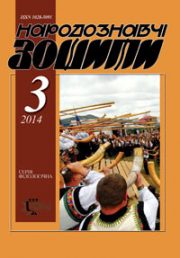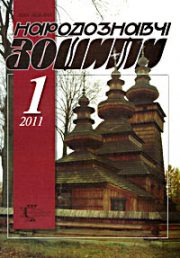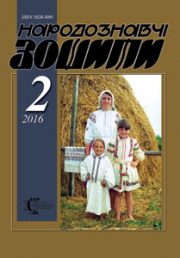The Ethnology Notebooks. 2020. № 2 (152), 350—360
UDK 398.332.4(=161.2) (292.452)
DOI https://doi.org/10.15407/nz2020.02.350
MANTIC CEREMONIAL ACTIONS WITH RITUAL BREAD IN THE WINTER RITES OF THE CARPATHIAN UKRAINIANS
Serebryakova Olena
ORCID ID: https://orcid.org/0000-0002-1039-2920
Candidate of Historical Sciences,
Research worker of the Department of the Modern Ethnology
of the Ethnology Institute
of the National Academy of Sciences of Ukraine,
15, Svobody Avenue, 79000, Lviv, Ukraine,
Contacts: e-mail: o-sereb@ukr.net
Abstract. Actuality of the article is conditioned by the fact that there is still no special research about the local peculiarities of the existence of mantic actions with ritual bread in Ukrainian Carpathians. They were carried out by the Highlanders during the winter holidays, in particular the time of the twelve days between Christmas and Epiphany. Therefore, the aim of the offered article is coverage of the layer of ritual and world-view phenomena associated with the divination about the longevity, the harvest, the various positive or negative events that are about to happen. Among them — varieties, prophetic signs, in particular signs during baking, ritual taboos, mythological presentations, archaic elements etc. Also different mantic-magical actions were performed to increase the yield, the number of livestock, money, health, good.
The object of the research is the traditional world view and the custom and rite culture of the Carpathian Ukrainians, and the subject — the mantic actions with ritual bread, which carried out to various holidays of Christmas and Epiphany time. The basis for the article is the archival field materials of 1971—2019 from three historic and ethnographic regions of the Ukrainian Carpathians (Hutsulschyna, Boykivshchyna, Lemkivshchyna) and works of the end of nineteenth and the beginning of the twenty-first centuries. The methodology of this work is based on general scientific methodological principles and the basic requirements that apply to the works of historical and ethnological direction.
Mantic traditions related to the ceremonial use of ritual bread in the winter rites (the time of the twelve days between Christmas and Epiphany) of the Carpathians inhabitants are analyzed. Their functional purpose, semantics, symbolism and magical properties of ritual bread and other attributes (water, hemp, honey, ritual food etc.), the degree of preservation of the studied phenomena in modern times are revealed.
Due to direct contact with ritual bread, various attributes to be charged by the magical power that was transmitted to man, livestock and field. Therefore, they acquired healing, productive and protective properties. Christmas bread was used during the water consecration of family members and the whole yard, as well sowing in the spring, using part of the ritual bread.
Among the remnants of archaic phenomena the cult of ancestors, belief in divination, verbal, productive magic, the magic of protection, magical properties of ritual attributes and their use in various mantic and magic actions etc. was preserved. According to the field records of investigated divination and magic actions are still stored in memory of old local people in the villages of Ukrainian Carpathians.
Keywords: mantic actions/practices (divination), Carpathian Ukrainians, ritual bread, winter rite, life, death, crop, wedding.
Received 17.02.2020
REFERENCES
Sosenko, K. (1928). Cultural and historical figure of the old Ukrainian holidays of Christmas and Generous Evening. Lviv: Nakladom avtora [in Ukrainian].
Tokarev, S.A. (1957). Religious beliefs of the East Slavic peoples of the 19th — early 20th centuries. Moskva; Leningrad: Izd-vo Akad. nauk SSSR [in Russian].
Kis, R., & Maierchyk, M. (2006). Agrarian layer of the archaic ritualism of the Carpathian region. In Ethnogenesis and ethnic history of the people of the Ukrainian Carpathians: in 4 vol. (Vol. 2, pp. 459—472). L’viv: IN NANU [in Ukrainian].
Kutel’makh, K.M. (2006). Calendar ritualism as an ethnogenetic source. In Ethnogenesis and ethnic history of the people of the Ukrainian Carpathians: in 4 vol. (Vol. 2, pp. 473—557). L’viv: Institute of Ethnology of the National Academy of Sciences of Ukraine [in Ukrainian].
Horoshko, L. (2008) «Water» symbolism of the rite of bathing of the christmas bread. History of religions in Ukraine. Scientific annual (B. 1, pp. 49—56). L’viv: Lohos [in Ukrainian].
Dictionary of Ukrainian: in 11 vol. (Vol. 1). Kyiv: Naukova dumka [in Ukrainian].
Archive of the IN NANU (Archive of the Institute of Ethnology of the National Academy of Sciences of Ukraine). F. 1. Op. 2. Od. save 215 [in Ukrainian].
Archive of the IN NANU. F. 1. Op. 2. Od. save 209 [in Ukrainian].
Archive of the IN NANU. F. 1. Op. 2. Od. save 212 [in Ukrainian].
Archive of the IN NANU. F. 1. Op. 2. Od. save 214 [in Ukrainian].
Archive of the IN NANU. F. 1. Op. 2. Od. save 227 [in Ukrainian].
Archive of the IN NANU. F. 1. Op. 2. Od. save 230 [in Ukrainian].
Archive of the IN NANU. F. 1. Op. 2. Od. save 240 [in Ukrainian].
Archive of the IN NANU. F. 1. Op. 2. Od. save 513 [in Ukrainian].
Archive of the IN NANU. F. 1. Op. 2. Od. save 533 [in Ukrainian].
Archive of the IN NANU. F. 1. Op. 2. Od. save 588 [in Ukrainian].
Archive of the IN NANU. F. 1. Op. 2. Od. save 590 [in Ukrainian].
Archive of the IN NANU. F. 1. Op. 2. Od. save 609 [in Ukrainian].
Bogatyrev, P.G. (1971). Magical actions, rites and beliefs of Zakarpattya. Issues of the theory of folk art. Moskva: Iskusstvo [in Russian].
Simonenko, I.F. (1948). Life of the population of Zakarpattya region (based on materials from of expeditions 1945—1947). Sovetskaja jetnografija (Vol. 1, pp. 63—89) [in Russian].
Falkowski, J., & Pasznycki, B. (1935). On the border of Lemkowsko-bojkowskiem. Lwow: Nakladem tow-wa ludoznawczego [in Polish].
Schnaider, J. (1899). From the land of the Hutsuls (Hutsul calendar). Lud, III (Vol. V, pp. 207—220). Lwow [in Polish].
Schnajder, J. (1912). From the life of the highlanders, who live above the river Limnytsia. Lud, I—IV (Vol. XVIII, pp. 141—217). Lwow [in Polish].
Archive of the IN NANU. F. 1. Op. 2. Od. save 521 [in Ukrainian].
Archive of the IN NANU. F. 1. Op. 2. Od. save 607 [in Ukrainian].
Hajova, Ye. (2011). Philosophy of being in Lemkos’ winter rites and customs (Christmas, Basil, «Grannie’s Holy Evening», John the Baptist, holiday meeting of winter and spring) on the expedition materials, collected in the Velykoberezniansky district of Zakarpattya region. A calendar rite in the vital functions of ethnos. Collection of scientific works: are materials of the International scientific conference the «Odesa ethnographic readings». Odesa [in Ukrainian].
Turians’ka, M. (1934). Boykos’ customs from Christmas holidays, New Year and Christening. In Litopys Bojkivschyny (P. III, pp. 23—27). Sambir [in Ukrainian].
Komarnyts’kyj, I. (1989). Christmas customs in the village of Lopushanka Khomina in the Turka district. Litopys Bojkivschyny (P. 1/49, pp. 67—69). Sambir [in Ukrainian].
Archive of the IN NANU. F. 1. Op. 2. Od. save 217 [in Ukrainian].
Archive of the IN NANU. F. 1. Op. 2. Od. save 458 [in Ukrainian].
Archive of the IN NANU. F. 1. Op. 2. Od. save 550 [in Ukrainian].
Vasylechko, L. (1994). Palm Sunday. Folk customs, ceremonies and popular beliefs. Broshniv: Talia [in Ukrainian].
Zubryts’ky, M. (1900). Folk calendar. Folk customs and beliefs associated with days of the week and yearly holidays (in Mshanets’ of the Staromis’kyj district and on nearby villages). Materialy do ukrains’ko-rus’koi etnolohii (Vol. 3, pp. 33—60). Lviv [in Ukrainian].
Archive of the IN NANU. F. 1. Op. 2. Od. save 691 [in Ukrainian].
Onyschuk, A. (1912). Folk calendar. Customs and beliefs associated with single days in a year (In 1907—10 in Zelenytsia of Nadvirna district (on Hutsul’shchyna). Materialy do ukrains’koi etnolohii (Vol. XV, pp. 1—61) L’viv: Etnohrafichna komisiia NTSh [in Ukrainian].
NANF IMFE NAN of Ukraine (National archival scientific collections of manuscripts and audio recordings of M.T. Rylsky Institute of Art Studies, Folklore and Ethnology of the National Academy of Sciences of Ukraine). F. 14—3. Act. 6. Arc. 1—128 [in Ukrainian].
Kolberg, O. (Ed.). (1973). Sianots’ke-Kros’nens’ke. In Kolberg, О. All works (Vol. 51, p. 3). Wroclaw; Poznan’: Polskie towarzystwo ludoznawcze [in Polish].
Kmit, Yu. (1935). More about Volosatyj. Litopys Bojkivschyny (P. 6, pp. 1—9). Sambir [in Ukrainian].
Zdoroveha, N.I. (1983). National customs and rites. In Boykivshchyna: Historical and ethnographic research (Pp. 232—248). Kyiv: Naukova Dumka [in Ukrainian].
Archive of the IN NANU. F. 1. Op. 2. Od. save 222 [in Ukrainian].
Penhryn, M. (1990). Winter beliefs. Nashe Slovo, 3, 6. Varshava [in Ukrainian].
Duchymins’ka, O.O. (1939). The customs on Holy evening in a village Vovche to the Turka district. Zhinocha Dolia (P. 1—2, pp. 11—12). Kolomyia [in Ukrainian].
Malets’, V. (1930). Customs on Christmas in Khyrliava village. Podkarpatska Rus’ (P. 1—2, pp. 18—19). Uzhhorod [in Ukrainian].
Petrets’kyj, V. (1930). Christmas customs and traditions in Tur’ia-Bystra village. Podkarpatska Rus’ (P. 1—2, pp. 21—22). Uzhhorod [in Ukrainian].
Archive of the IN NANU. F. 1. Op. 2. Od. save 213 [in Ukrainian].
Savyts’ka, E. (2017, 12—19 January). In this day and fire magic. In Ekspres (P. 3). L’viv [in Ukrainian].
Chebaniuk, O. The housewife was removing Christmas bread from the oven in an inverted sheepskin coat. Retrieved from: https://gazeta.ua/articles/holydays-newspaper/_rizdvyanij-hlib-kerechun-gospodinya-vijmala-z-pechi-u-vivernutomu-kozhusi/417066 (Last accessed: 11.11.2019).
Kis’, R., & Maierchyk, M. (1998). Agrarian layer of the archaic ritualism of Carpathians (reasons are to the reconstruction of ethnogenetic processes). The Ethnology notebooks, 3, 274—278 [in Ukrainian].
NANF IMFE NAN of Ukraine. F. 14—5. Act. 5. Arc. 1—230 [in Ukrainian].
NANF IMFE NAN of Ukraine. F. 14—3. Act. 429. Arc. 1—150 [in Ukrainian].
Archive of the IN NANU. F. 1. Op. 2. Od. save 317 [in Ukrainian].
Zborovs’kyj, P. (2000—2002). Christmas cycle of holidays according to the tradition of the village Verkhne Vysocke in Turka district. Bojky (Pp. 215—220). Drohobych [in Ukrainian].







